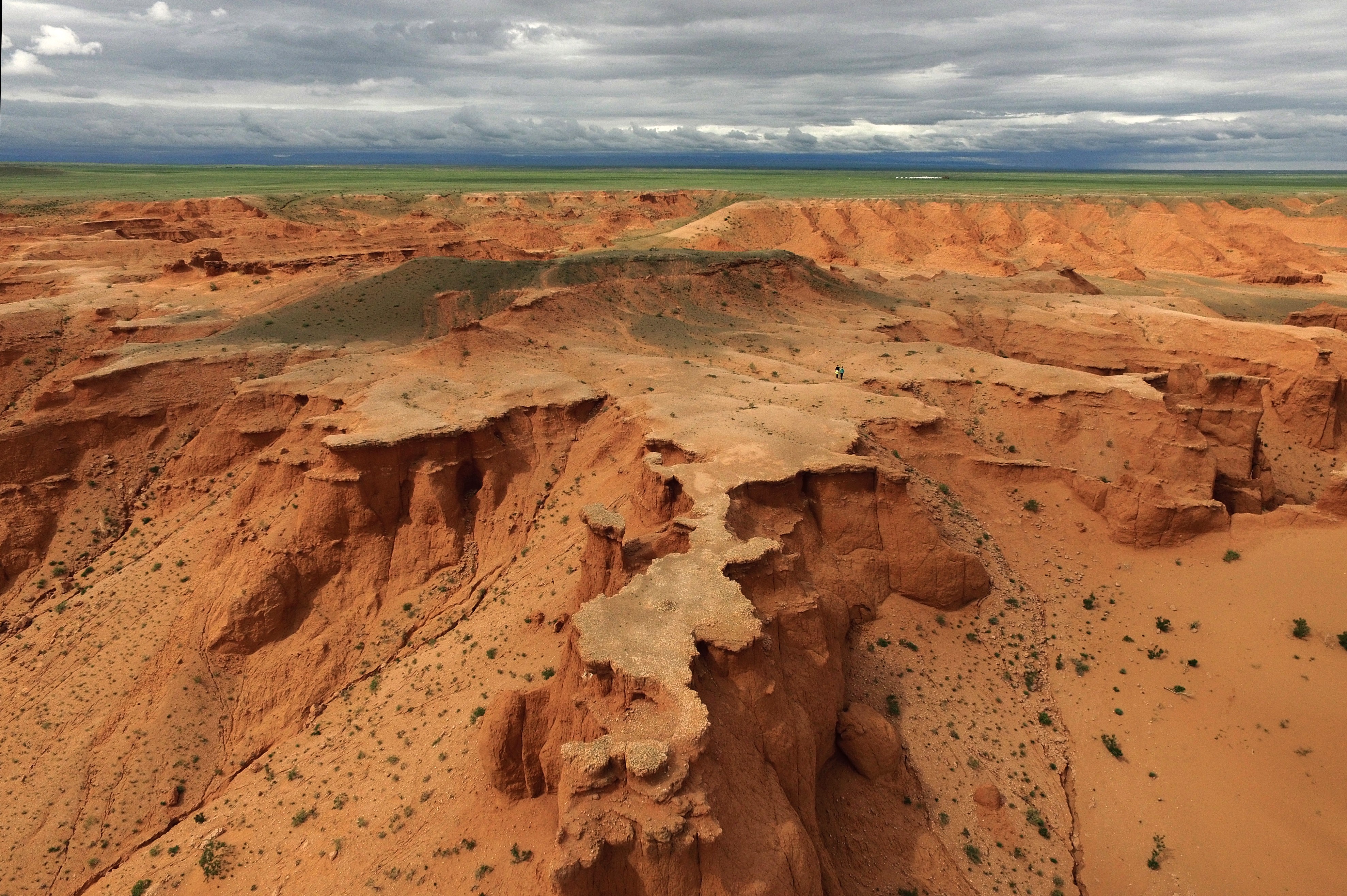
- Unearthed by poachers in the 2000s, the Halszkaraptor escuilliei is a unlike anything seen before
- Having changed hands a number of times across continents, it is finally ready to return
Desolate and beautiful, southern Mongolia’s Gobi Desert is a vast, treeless expanse, with few permanent settlements and even fewer paved roads. It was here, amid the crumbling outcrops of a fossil site known as Ukhaa Tolgod, that the poachers struck.
The thieves would have worked methodically, digging out a half-metre-long block of soft red sandstone containing the whitish bones of a small dinosaur. They likely doused the skeleton with superglue, a crude substitute for the substances that palaeontologists use to harden and protect fossilised bone. Then they probably wrapped the block in hessian and plaster, loaded it into a four-wheel-drive truck, and drove away, leaving smashed pieces of bone and bottles of superglue strewn across the desert.
They had something valuable in their possession, that much the poachers would have known. What they could not have guessed was that it would turn out to be such a sensational discovery. Nor could they have known the epic journey this fossil would take around the world, passing through the hands of criminals, dealers and scientists – only to end up right back where it began, in Mongolia, a decade later.
One reason the country is such a hotbed for fossil poaching is that unlike most places, it has great tracts of exposed Cretaceous rock in areas devoid of vegetation. Dinosaur bones are abundant here, and relatively easy to find. It is impossible to say exactly how many have been smuggled out of the country since the trade began in the 1990s, says Bolortsetseg Minjin, a Mongolian palaeontologist based in New York, in the United States. She estimates that at least “hundreds of partial or complete dinosaur skeletons have been poached, as well as thousands of other fragmentary remains and eggs”.

The first obstacle that the Ukhaa Tolgod poachers would have faced was getting their bounty out of the country. Philip Currie, a palaeontologist at the University of Alberta, in Canada, who has worked in the Gobi for decades, says a good bet is that they were hidden in trucks carrying coal mined in Mongolia to China. “We think they are loaded into the back of the coal trucks and buried,” he says.
At a certain point in its mysterious journey, the plaster-encased fossil would have been taken to a workshop, where a preparator employed by the smugglers would have cleaned off some of the superglue as well as part of the rock and sediment encasing the fossil. With the skeleton now half exposed for the first time in tens of millions of years, the poachers would have had their first proper look at their swag: the remains of a weird goose-sized dinosaur, with sharp claws and birdlike features.
In about 2010, the fossil surfaced in Europe. It arrived with a fossil dealer in Britain and also went on display in 2011 at the Munich Show, a trade fair for minerals, gems and fossils, in Germany. It was photographed and even briefly appeared on eBay. A buzz was beginning to build.
One of those who noticed it was François Escuillié, the owner of Eldonia, a fossil dealership in France. As well as trading in fossils, he has made a habit of buying important black market specimens and donating them to museums so they can be studied. “This guy has lost a lot of money,” jokes Pascal Godefroit, a palaeontologist at the Royal Belgian Institute of Natural Sciences, in Brussels. Escuillié’s efforts have earned him respect among scientists and even immortality of a sort after grateful researchers named an early elephant after him.
Escuillié showed Godefroit images of the new dinosaur. Even though only one side of its skeleton was visible, with the rest buried inside the rock, he was captivated.
“Sh*t! What is it?” were the first words out of Godefroit’s mouth. The body appeared to be that of a dromaeosaur, a group that includes speedy, predatory dinosaurs such as velociraptors. Attached to it, however, were what resembled the neck of a swan and a skull with a flattened, duck-like snout. “The question was: was it real?” says Godefroit. “It really looked like a chimera.”
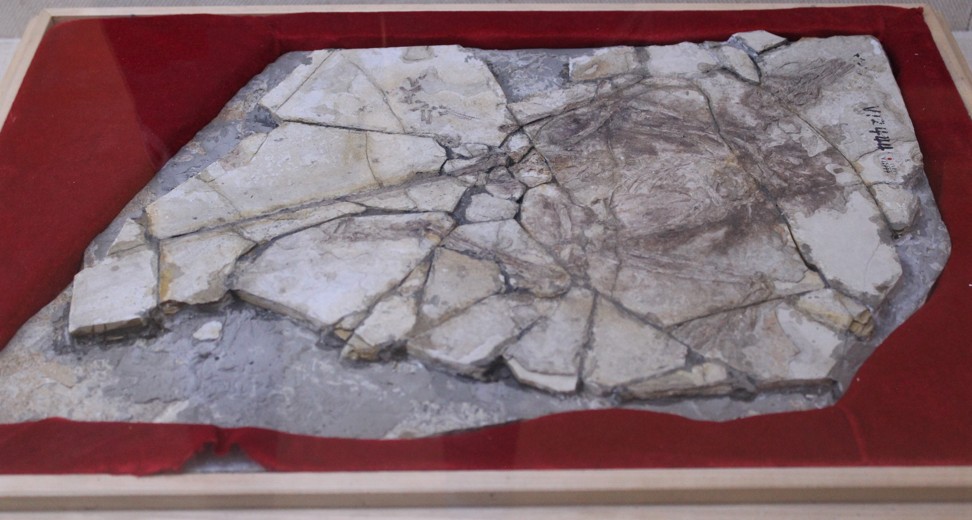
Chimeras are forgeries created by combining fossils. The most famous, dubbed Archaeoraptor, was announced as a new feathered dinosaur in 1999. It was, in fact, made from pieces of a fossilised dinosaur and a bird. The best chimeras seem to be created by skilled forgers in northeast China. They combine Chinese fossils, such as feathered dinosaurs, that have dark bones embedded in grey rock and are preserved squashed almost flat.
The new dinosaur didn’t appear to be from northeast China. It was preserved in three dimensions and had white bones in reddish rock and sediment reminiscent of the Gobi Desert. It also had a label that read “Central Asia”. All of which hinted that it was Mongolian and possibly genuine, but Escuillié and Godefroit hummed and hawed about what to do.
The decisive moment came in May 2014 when the pair were in Mongolia returning the skull of a Deinocheirus that Escuillié helped rescue. Godefroit’s institute is the only one that has an agreement with Mongolia to repatriate stolen fossils, and both men have a relationship with Khishigjav Tsogtbaatar, director of the Institute of palaeontology and Geology, in Ulan Bator, the nation’s capital. Sitting down together, Tsogtbaatar produced a photo of the dinosaur in the reddish soil from the Munich Show and said: “We need this specimen.”
Escuillié returned home and immediately bought the fossil for an undisclosed sum. He picked it up in June 2014 at the Mineral and Gem International Show, in Sainte-Marie-aux-Mines, France. Soon afterwards, he took it to Brussels, secured in a small wooden box.
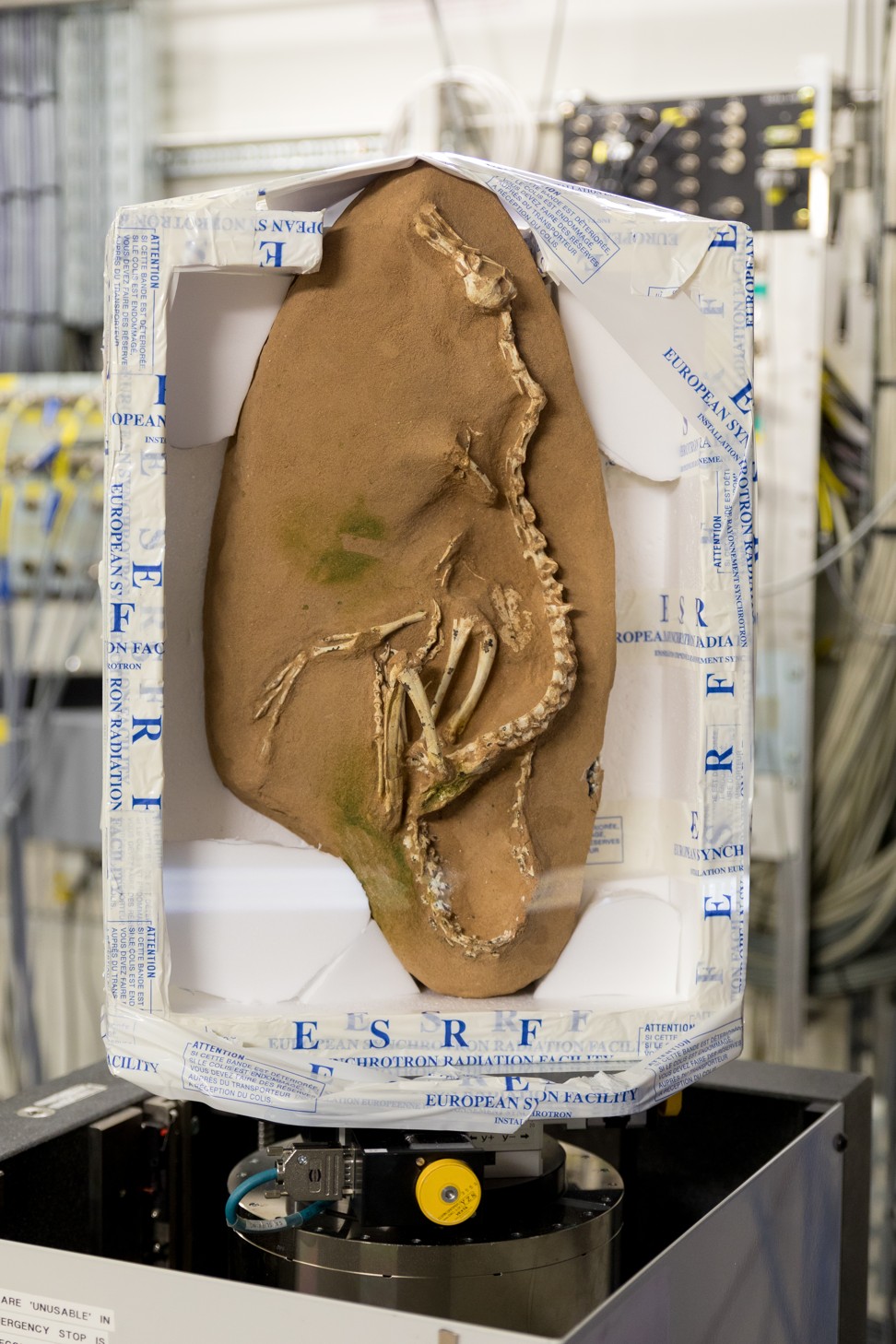
By now both he and Godefroit were convinced the specimen was genuine. There were notes attached to the specimen, perhaps added by the poachers or dealers who had handled it along the way, that suggested it came from Ukhaa Tolgod.
Proving this was going to be seriously tricky. But it had to be done, because confirming the provenance of fossils is essential if they are to be dated, which is important if specimens are to be scientifically useful. The problem is that carbon dating is no good for dinosaur bones. Too many radioactive carbon atoms have decayed for the technique to be useful on anything more than about 50,000 years old.
Instead, fossils are typically dated from the age of the rocks in which they are found, which themselves are dated using geological maps and other radiometric dating methods. But no detailed information was available about the fossil’s provenance. So Godefroit gathered a team to study the dinosaur, with the first task being to pin down where it came from.
Palaeontologist Andrea Cau, then at the University of Bologna’s Giovanni Capellini Museum of Geology, came to Brussels for six months to study the specimen. Together, the team discovered that the fine reddish-orange rock around it closely matched that of fossil-rich layers at Ukhaa Tolgod. This dated the dinosaur to the Late Cretaceous period, some 71 to 75 million years ago.
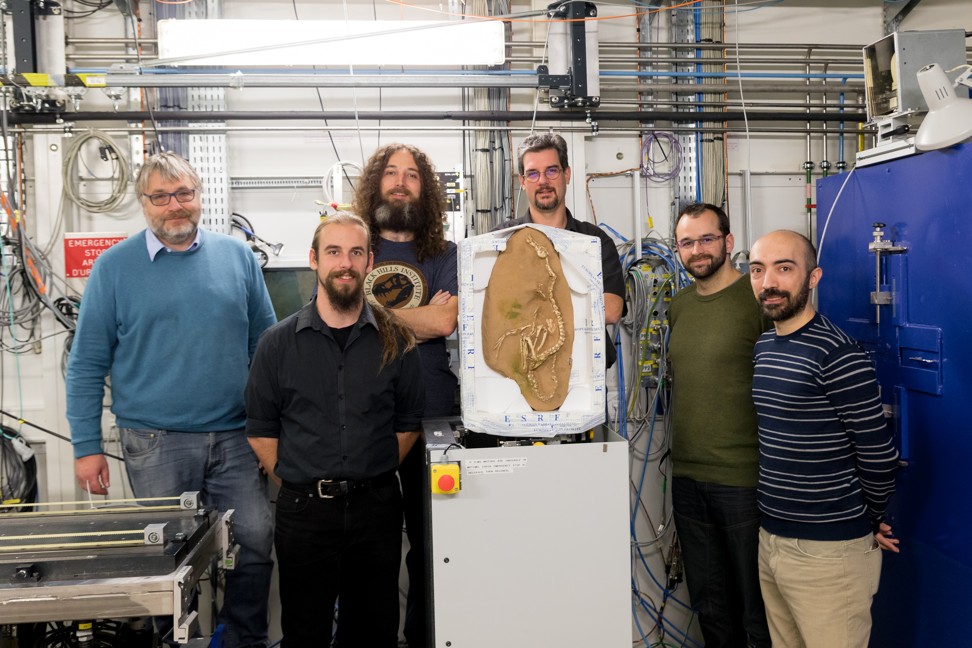
The next step was to get a look at the half of the skeleton still buried in the rock. The researchers X-rayed the specimen but the density difference between the bones and the sediment was too small to produce clear images. They tried to publish their evidence in 2016, but other experts rejected the findings on the grounds that the fossil looked so strange it had to be fake.
So they rolled out the big guns. Godefroit and his team took the specimen to the European Synchrotron Radiation Facility, in Grenoble, France: Europe’s brightest source of X-rays. With the help of Paul Tafforeau, who leads the facility’s palaeontology work, they carried out the world’s first synchrotron scan of an entire dinosaur fossil.
It worked beautifully, delivering a pin-sharp reconstruction of the entire fossil. Hidden parts of the skeleton mirrored those on the surface, making a strong case for it being genuine. What made it watertight was the discovery of a matching seam of increased bone density, known as a line of arrested growth, running through the whole skeleton.
The scan didn’t just prove that the skeleton was legitimate, it showed it was even stranger than Godefroit had thought. The animal had stumpy, wing-like arms and many tiny conical teeth. Those teeth and the long neck brought to mind a fish-eating plesiosaur, says Godefroit. Taken together, they suggest a predator that spent much of its time in the water, snapping up fish in Cretaceous lakes and rivers. It probably used its unusual forelimbs in the same way a penguin uses its wings: to pull itself forward in the water.
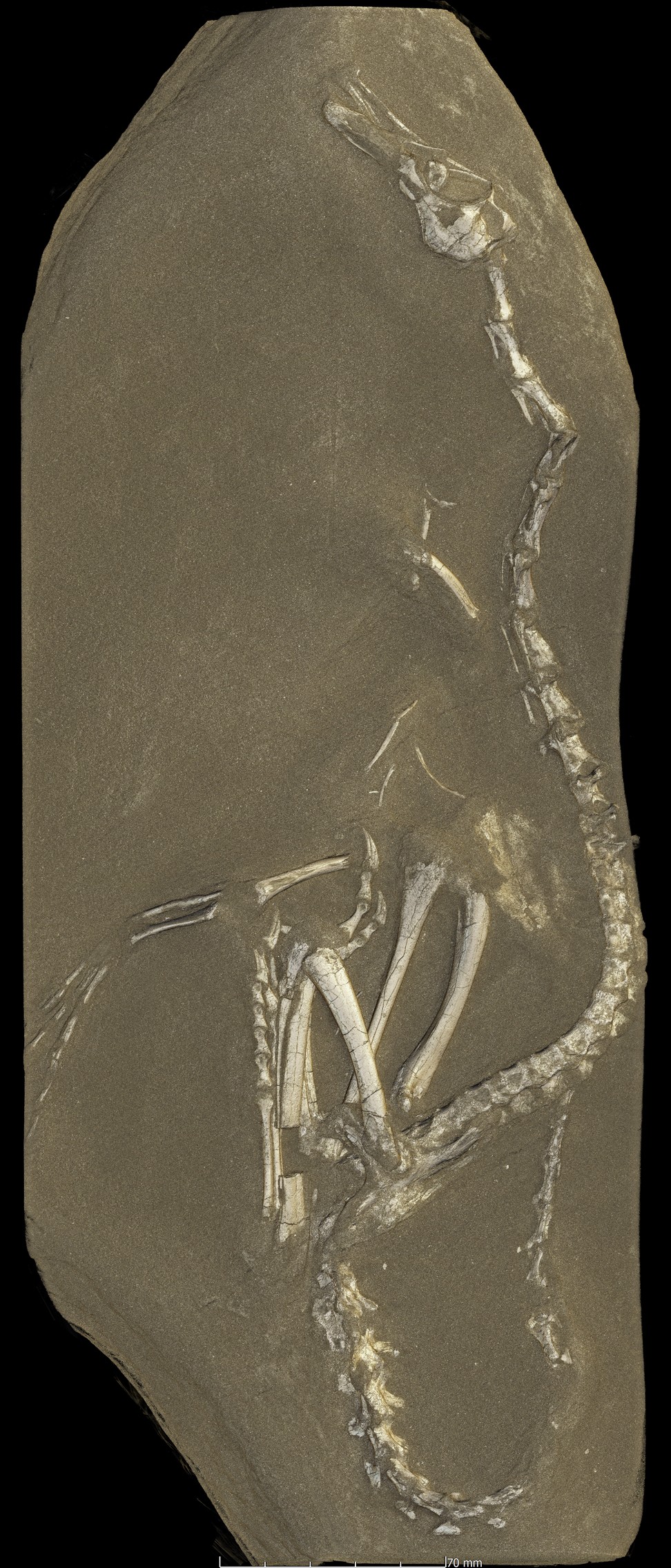
It is hard to overstate how odd that is. Many giant reptiles lived in the seas at the same time as the dinosaurs, but there are only two other dinosaurs known to have been highly adapted for swimming: a small armoured dinosaur from China that led a turtle-like existence and the giant, fish-eating carnivore Spinosaurus.
That did it. In 2017, Godefroit and his collaborators, including Currie, Cau and Tsogtbaatar, finally published a description of the dinosaur in scientific journal Nature, naming it Halszkaraptor escuilliei. That honoured both Escuillié for rescuing the fossil and pioneering palaeontologist Halszka Osmólska, who led a series of Polish expeditions to the Gobi Desert starting in the 1960s.
One study published in November last year questioned whether the anatomical features of the specimen really indicated it had been semiaquatic. But most palaeontologists have enthusiastically supported the idea.
Cau still has reservations over the team’s having been unable to precisely determine the fossil’s provenance. But Currie and other palaeontologists, such as Phil Bell, at the University of New England, in Australia, have been developing a technique that might help. It uses the unique geochemistry of rocks and fossils to link specimens to their original locations. Armed with handheld X-ray fluorescence scanners, his team has been recording the geochemical profiles of sites such as Ukhaa Tolgod and comparing these with the signatures of fossils known to be from those sites.
That is not the only method that might be useful. Fossils from this part of the Gobi accumulate uranium, giving them unique radioactive profiles. It might be possible to use this to help pin Halszkaraptor to a specific site, says Currie, because the radioactive profiles of the fossil and the rocks it came from are likely to match up.
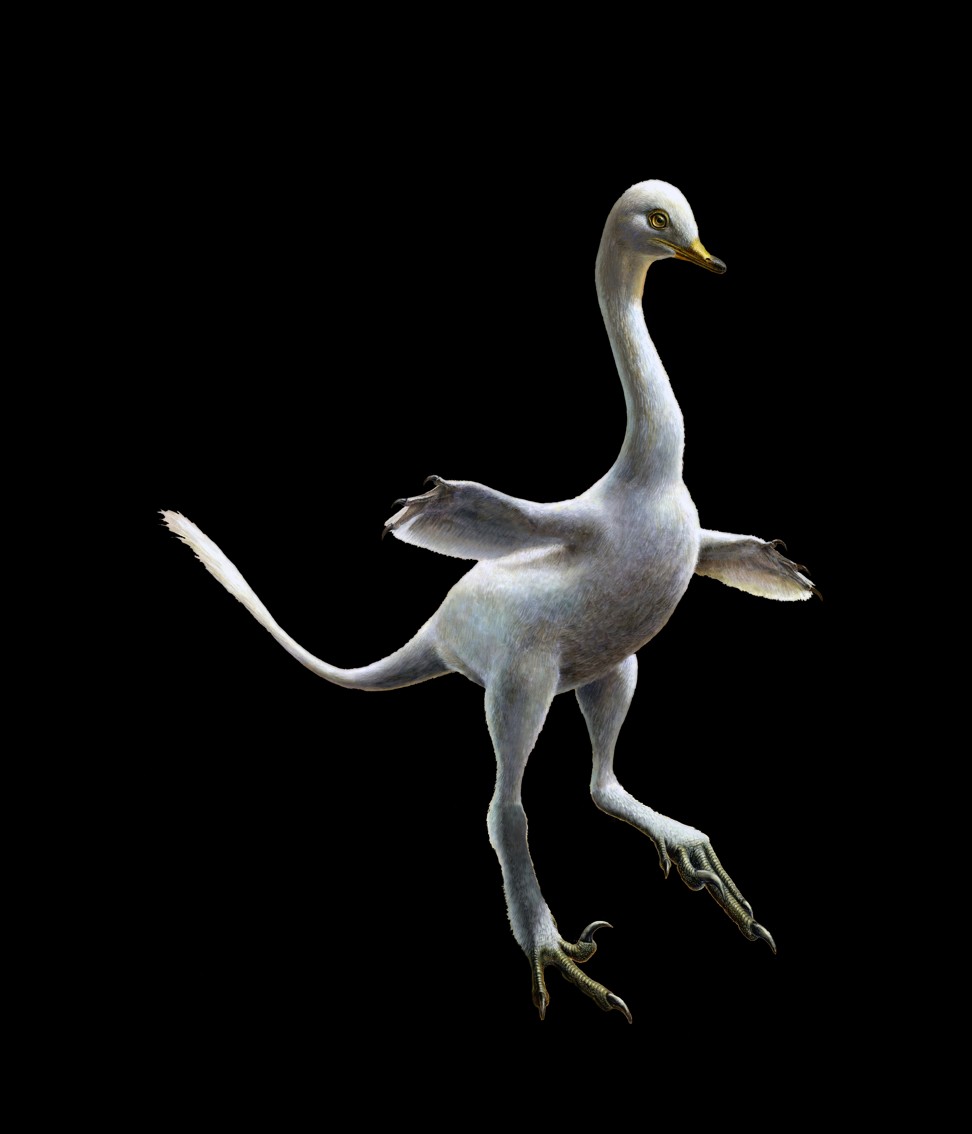
Further tantalising clues are emerging that this species is part of a wide family of waterfowl-like dinosaurs. Cau used Halszkaraptor’s skeleton as a Rosetta Stone to show that two previously described Mongolian dinosaurs, known only from fragmentary skeletons, were close relatives. A South Korean group is also studying the skeleton of another new halszkaraptorine from Mongolia, reports on which are yet to be published, and Godefroit is studying a possible relative in China.
None of this would have come to pass had that fossil disappeared into a private collection and Escuillié hadn’t brought it to Godefroit’s attention. “There’s nothing like this animal around and if it wasn’t for people trying to get around this issue of poaching, we would never see these fossils,” says Bell.
That lends a certain poignancy to the next step in the dinosaur’s journey. Godefroit will soon repatriate it, and may fly alongside Escuillié to take it to Ulan Bator’s Institute of palaeontology and Geology. They are waiting for the call from the Mongolian embassy in Brussels. “If they say to us, ‘Please send it to us next week,’ it’s OK. We can do it,” says Godefroit.
Much has changed in Mongolia since Halszkaraptor was roughly extracted from its rocks. In 2012, a poached Mongolian Tarbosaurus – a relative of Tyrannosaurus rex – was auctioned in New York for more than US$1 million. That caused an outcry among scientists and Mongolian officials. In the aftermath, the Tarbosaurus specimen and a huge number of other smuggled dinosaurs that had ended up in the US were impounded and returned to Mongolia. They now fill Ulan Bator’s old Lenin Museum, rebranded the Central Museum of Mongolian Dinosaurs.
“Despite having a wealth of fossils, Mongolia never had a designated museum for dinosaurs,” says Oyungerel Tsedevdamba, the former Mongolian minister of culture, sports and tourism, who helped to repatriate the fossils in 2014. “If you saw how people greeted Tarbosaurus bataar when it arrived in Ulan Bator, you would understand how important the restoration of cultural heritage is to the Mongolian people.”
Text: New Scientist
